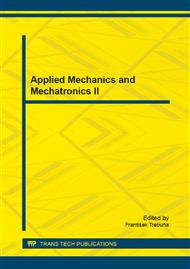[1]
Y. -J. Yum, H. Hwang, M. Kelemen, V. Maxim, and P. Frankovský, In-pipe micromachine locomotion via the inertial stepping principle, Journal of Mechanical Science and Technology 28 (8) (2014), 3237-3247.
DOI: 10.1007/s12206-014-0734-x
Google Scholar
[2]
A. Degani, S. Feng, H. Choset, and M. T. Mason, Minimalistic, Dynamic, Tube Climbing Robot, Proc. of 2010 IEEE Int. Conf. on Robotics and Automation Anchorage Convention District, May 3-8, 2010, Anchorage, Alaska, USA. (2010) 1100-1101.
DOI: 10.1109/robot.2010.5509948
Google Scholar
[3]
T. Izumikawa, H. Yaguchi, Cableless magnetic actuator capable of high-speed movement in pipe by new type propulsion module In: Advanced Materials Research Vol. 452-453 (2012), pp.1252-1256 ISSN: 1022-6680.
DOI: 10.4028/scientific5/amr.452-453.1252
Google Scholar
[4]
J. Guo, et al. Development of Wireless Endoscope with Symmetrical Motion Characteristics, In: International journal of advanced robotic systems Vol. 11, no. 148 (2014), pp.1-13 ISSN: 1729-8806.
DOI: 10.5772/58925
Google Scholar
[5]
A. Vitko, L. Jurišica, M. Kľúčik, F. Duchoň, Context Based Intelligent Behaviour of Mechatronic Systems, Acta Mechanica Slovaca. - ISSN 1335-2393, Vol. 12, No. 3-B. (2008) pp.907-916.
Google Scholar
[6]
A. Vitko, L. Jurišica, A. Babinec, F. Duchoň, M. Kľúčik, Some Didactic Problems of Teaching Robotics, Proceedings of the 1st International Conference Robotics in Education 2010. Bratislava, 16. -17. 9. 2010, Bratislava, Slovak University of Technology in Bratislava, ISBN 978-80-227-3353-3, (2010).
Google Scholar
[7]
D. Koniar, L. Hargaš, M. Hrianka, The application of DICOM 7th standard in LabView, Proc. of Biom. Eng., Kladno (2007).
Google Scholar
[8]
E. Ostertagová, Computer aided teaching of math at FEI TU in Košice, In: Proceeding of Int. Conf. on Inovation Process in E-learning, Bratislava, March, 10th (2011). pp.1-5. - ISBN 978-80-225-3112-2.
Google Scholar
[13]
Li-Hong Juang, Ming-Ni Wu, Zhi-Zhong Weng, Object identification using mobile devices, Measurement, Volume 51, May 2014, Pages 100-111, (2014).
DOI: 10.1016/j.measurement.2014.01.029
Google Scholar
[14]
M. Dekan, F. Duchoň, L. Jurišica, A. Vitko, A. Babinec, iRobot Create Used in Education, Journal of Mechanics Engineering and Automation. - ISSN 2159-5275. - ISSN 2159-5283. - Vol. 3, Iss. 4, 2013, pages 197-202, (2013).
DOI: 10.17265/2159-5275/2013.04.002
Google Scholar
[15]
L. Hargaš, M. Hrianka, D. Koniar, and P. Izák, Quality Assessment SMT Technology by Virtual Instrumentation, Applied Electronics 2007, Pilsen, 5. – 6. 9. 2007, (2007), ISBN 987-80-7043-537-3.
Google Scholar
[16]
P. Pásztó, P. Hubinský, Mobile Robot Navigation Based on Circle Recognition, Journal of Electrical Engineering, Vol. 64, No. 2 (2013), 84-91.
DOI: 10.2478/jee-2013-0012
Google Scholar


